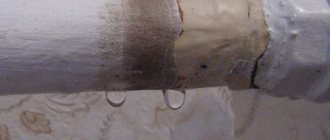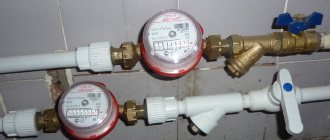Central heating
- installation of automatic balancing valves on rings, risers, branches of the heating system;
- adjustment of the heating system.
- repair/replacement of pipelines, risers, connections to heating equipment;
- repair/replacement of air vents, expansion tanks, thermal air curtains, etc.
- restoration of the panel heating system;
- installation of an automated control unit (ACU) of the heating system, its installation and startup;
- installation of a common house metering unit for heat energy consumption (if not available);
- installation of heating devices with attached or built-in automechanical thermostats;
- installation of pipeline shut-off valves.
Frequency of major repairs
The efficiency and security of networks depends on how timely their reconstruction is carried out. Each type of in-house engineering communications has its own frequency of major repairs. In particular, for the main networks, the regulatory documentation establishes the following deadlines:
- major repairs of in-house engineering heat supply systems - 25 years;
- hot and cold water supply - 15 years (with galvanized risers - 30 years);
- replacement of in-house power supply networks - 20 years;
- replacement of cast iron sewer risers - 40 years;
- replacement of plastic and ceramic sewer risers - 60 years.
If the deadlines for major repairs are violated, utility networks fall into disrepair. This results in emergencies that lead to significant material damage. There may also be a threat to the safety of residents and building maintenance personnel. Therefore, the organization operating a residential building is obliged to strictly control the service life of the systems and carry out repair work in a timely manner.
However, the need for major repairs may arise earlier than the deadline established by the regulations. The service life of systems depends on many factors, including the quality of installed elements, the quality of installation work, operating conditions, etc. Therefore, in some cases, critical wear may occur earlier. The presence of serious problems can be indicated by various disruptions in the operation of communications, for example, a significant decrease in water pressure on the upper floors, poor heating of heating radiators, the appearance of an unpleasant odor from the basement or from ventilation ducts, frequent blockages in sewer risers, malfunctions of electrical equipment, etc. d.
Cold and hot water supply
- depreciation of pipework;
- repair/replacement of pipelines, dryers, which relate to general building engineering systems;
- installation of individual cold and hot water meters and creation of in-house technical systems;
- installation of pipeline shut-off valves;
- preparation of sites for the installation of individual cold and hot water meters;
- replacement of plumbing fixtures in apartments owned by the city of Moscow;
- repair/replacement of fire water supply pipeline.
- installation of a household fire hydrant with a hose on the cold water pipeline in apartments.
Current and major repairs
Work to restore the engineering systems of an apartment building is divided into current and major repairs.
Current repairs of in-house engineering cold water supply systems and other communications include the elimination of local faults and malfunctions. During such repairs, individual elements of the system that are damaged, defective, or have served their intended service life may be replaced. For example, sections of pipelines, shut-off valves, power distribution devices, etc. are being replaced. Regular maintenance allows you to extend the service life of utilities and ensure their proper operation with maximum efficiency.
A major overhaul of in-house engineering systems involves their complete replacement or the replacement of a significant part of them. It is envisaged to be carried out when certain periods are reached, at which the wear of the equipment approaches a critical level.
Garbage chutes
- installation of a system for cleaning, rinsing and disinfecting the waste chute;
- finishing work in the garbage department;
- repair/replacement of waste chute components;
- repair/replacement of the heating system, cold and hot water supply and sewerage in the garbage department.
This concludes the repair of engineering systems. We recommend entrusting this type of work to professionals. KEP specialists are ready to carry out high-level repairs of engineering systems, as well as a full range of electrical work, including installation of street lighting fixtures, replacement of worn-out sections of the network or its overhaul, measurements of electrical wiring resistance at a price no higher than the current average in Moscow.
come back
Scope of work for major repairs
The list of works during major repairs is individual for each type of utility network. It also depends on their technical condition and configuration features.
When repairing in-house heating and water supply engineering systems, risers and distribution lines, shut-off, shut-off and control, and safety valves are replaced. Pumping and control equipment may change. Heating networks additionally provide for system balancing, replacement or repair of air vents, installation of an individual heating point and other equipment. Heating radiators or other heating devices in common areas are being replaced.
Major repairs of water drainage and sewerage include the replacement of sewer risers and deck chairs. The internal drainage of the house is also changed or reconstructed, and a drainage system is installed. Sewage valves are being installed, which ensure more comfortable use of the system and prevent emergency situations.
The overhaul of in-house power supply systems includes the replacement of electrical wiring and input and distribution devices. New house, entrance, and floor electrical distribution panels are being installed, and protective equipment is being changed. This also includes the replacement of general building lighting networks, emergency lighting, and outdoor lighting. Photoswitches and other advanced equipment can be installed to increase the efficiency and economy of the system. The power supply networks for the engineering equipment of the house are changing.
Gas supply networks are replacing in-house and façade gas pipelines. New gas equipment and shut-off valves are being installed. Gas distribution lines are being replaced or repaired.
Major ventilation repairs in an apartment building include cleaning ventilation ducts and replacing ventilation grilles. When mechanically driven forced ventilation is used in a building, work is carried out to diagnose and overhaul the equipment.
How to request early major repairs
Overhaul of engineering systems of residential buildings is carried out in accordance with the regional program, which sets specific deadlines for each building. Therefore, completion of work ahead of schedule is possible only if there are grounds.
To do this, residents of the building must submit a corresponding application to the HOA, management company or other organization on whose balance sheet the building is located. The application is drawn up in free form, indicating the essence of the problem, the date of the last inspection, and a description of the condition of the networks.
Based on the submitted application, examinations are carried out, during which the actual condition of engineering systems and the need for major repairs are assessed. After this, an application is submitted to make changes to the regional program, and emergency communications are overhauled.
Equipment that the management company should not repair for free
The management company is not obliged, at its own expense, to carry out free repairs of the following equipment in the apartments of premises owners in apartment buildings:
- individual metering devices for hot and cold water, gas, electricity;
- gas and electric stoves;
- plumbing equipment in the apartment (faucets, taps, bathtubs, sinks, toilets, water heaters);
- pipes and bends installed on branches from risers after the shut-off device or shut-off and control valve;
- intercoms in the apartment;
- electrical cables, sockets in the apartment;
- other equipment not included in the common property , intended to serve only one apartment.
Repair of circulation pumps
To increase the speed of movement of the coolant in the heat supply, a circulation pump is installed. Its breakdown will not only worsen heat transfer, but will also negatively affect the performance of the entire system.
Despite the apparent complexity of the design, you can repair the heating pump yourself. To do this, first determine the cause of the problem and develop the optimal scheme to eliminate it. Before repairing the heating circulation pump, you should turn off the system and wait until the coolant cools down. This can be avoided if a bypass is installed on the pump unit. It is enough to redirect the movement of hot water along the spare circuit.
Self-repair of heating pumps is carried out only after detailed familiarization with the design features of a particular model. Then the device should be dismantled to further restore functionality. There are several causes of malfunctions, after identifying which repair work on the heating pump is carried out with your own hands.
Let's look at the most common of them, as well as ways to solve the problem:
- The power plant does not work. First you need to check the condition of the terminals - the fuse on them often blows due to power surges in the network. The solution is to replace the fuse;
- Increased noise during operation. To repair heating pumps in this case, it is necessary to remove air from the pipe. It is best to install an automatic air vent in advance;
- Strong vibration during operation. Most likely the bearing on the shaft has failed. To repair the heating circulation pump, you will need to replace it;
- Incorrect blade rotation. The connection phase should be checked, as well as the correct installation of the pump;
- A little pressure. Most often this is due to a clogged filter. In this case, it will not be necessary to repair the heat supply pump, but to clean the filter.
After long-term operation, some pump components lose their hermetic properties - the geometry of the impeller and shaft changes. To repair a heating circulation pump, the condition of these elements is first checked. Almost all models are designed to replace components. But before purchasing, you need to select the right components, writing down the brand of the pump and its model.
There should be a sealing lubricant on the gaskets and pipes of the pump. If it is missing, it must be reapplied.
I. Repair of in-house engineering systems of electrical, heat, gas, water supply, and sanitation
under the influence of constant humidity they rust and begin to leak. Lime and other substances contained in the water settle inside - the diameter of the pipe decreases - the flow of water is complicated.
Today there are modern polymer materials on the market. But! When choosing, you need to look at the maximum temperature the pipe can withstand. If for cold water supply risers this indicator is not important. The hot water riser may twist under the influence of too high a temperature.
The risers need to be replaced completely, from floor to ceiling. Partial replacement does not make sense. A piece of riser is changed only when, for example, a heated towel rail is changed. Then the “loop” is cut off, and in its place a straight piece of pipe with bends and shut-off valves is put in place. Then a heated towel rail is connected to them.
It is not recommended to hide any risers in the walls. They can be decorated or hidden in a plumbing box with a door behind which there will be taps, filters, a water heater, a manifold, etc.
The housing stock of most cities and urban-type settlements is very heterogeneous in terms of technical condition.
Repair of in-house engineering systems
According to the accepted schemes, complexity, installation method and material of the electrical wiring of most residential and public buildings, the wiring differs significantly. In many residential buildings, due to the increased use of household electrical appliances, the wire cross-section does not correspond to the actual load. Overloading of electrical wires in residential buildings is one of the most significant reasons for the deterioration of wire insulation and leads to the need to repair electrical wires.
Current electrical wiring repairs
residential buildings includes partial replacement of internal electrical wiring of lighting and power electrical installations; re-tightening of sagging electrical wiring in staircases, cages, attics and underground areas; checking the grounding of cable sheaths, shields and shields; re-tensioning of overhead line wires with adjustment of the sag, as well as stretching loose bands and changing attachments for composite single-post supports; re-cutting and termination of cable ends; cleaning the contact surfaces of devices from oxides, lubrication and regulation of their mechanisms, changing the coils of electromagnets.
During routine repairs of electrical wiring in residential buildings, the following rules must be observed. Dismantled wires, installation and fasteners, insulating parts and steel pipes must be thoroughly cleaned and inspected to determine whether they can be reused. Old wiring methods that do not meet current requirements should be replaced with new ones. The brands of newly laid wires and cables must correspond to the conditions and the accepted installation method, and the cross-sections of the wires must correspond to the specific design loads of residential buildings. Old, imperfect and unrepairable control equipment must be replaced with new ones.
Repair
apartments.
ELECTRICAL WIRING
MARKING - installation of all...
| Projects do not always indicate the exact installation locations of all elements electrical wiring . Therefore, their correct location must be determined based on ... bibliotekar.ru/spravochnik-85/145.htm |
Electrical wiring maintenance
| For repairs you must have a piece of wire or cable, plug sockets of the types that are used in this |
ELECTRICAL WIRING CONNECTIONS
.
Open wiring
. Master electrician...
| All connections in electrical wiring should only be in junction boxes. |
Repair
apartments.
Wiring
- connections of branch wires and...
| Therefore, when installing electrical wiring It is not recommended to use twisted connections (especially aluminum wires), and twisting copper wires with ... www.bibliotekar.ru/spravochnik-85/146.htm |
Wires, electrical wiring
.
Wiring repair
| If during repair electrical wiring If you don't have any insulating tape on hand, polyethylene will help out. Wrap the wire with plastic film tape, ... bibliotekar.ru/spravochnik-83/49.htm |
GROUNDING. Electrical Appliances, 120-Volt Wiring
…
| Typical 120 volt wiring always has a grounding wire, which is either exposed, ... To the contents of the book: |
WIRES, CORDS AND CABLES for electrical wiring
, types of wires, cables...
| For electrical wiring In the house, wire in a non-metallic sheath is most often used. |
ELECTRICAL REPAIR AND WIRING REPLACEMENT. Master electrician. Repair
, finishing...
| If capital is expected electrical wiring repair in your home, your local electrical inspector will tell you which bushing should be installed. … bibliotekar.ru/spravochnik-86/41.htm |
Wiring
.
CONSTRUCTION AND REPAIR
OF INTERNAL WIRING
| The shortest path along which it will pass is marked wiring . Using a long strip and a pencil, mark the lines and outline the locations of the sockets on the wall... www.bibliotekar.ru/spravochnik-102-remont-kvartiry/12.htm |
Connection of wires, cables, electrical wiring
.
Insulation from core...
| To the contents of the book: Repair apartments. |
To figure out who should maintain ownerless utility networks and at what cost, you must first clearly understand how such networks should be maintained if the owners are known.
The concept of “ownerless property” is disclosed in the Civil Code of the Russian Federation. According to Art. 225 of the Civil Code of the Russian Federation, an ownerless thing is one that meets one of the following criteria:
- there is no owner;
- owner unknown;
- the owner has renounced ownership of it (unless otherwise provided by law).
The primary basis for resolving problems with the maintenance of utility networks is to determine whether there is an owner, what the boundaries of ownership of the networks are, how the boundaries of property are determined, who maintains the networks and at what cost, and where the point of supply of utility resources is located.
In relation to the provision of utility services to owners and users of premises in an apartment building, it seems that it is necessary to begin with determining the boundaries of the common property in the apartment building.
The composition and characteristics of common property in an apartment building are legally defined in Part 1 of Art. 36 Housing Code of the Russian Federation. The main feature of common property in an apartment building is its purpose for serving several premises in an apartment building. The specific wording of this characteristic is set out as follows:
- paragraph 1 – “...engineering communications, other equipment serving more than one room in a given house”;
- paragraph 3 - “...mechanical, electrical, sanitary and other equipment located in a given house outside or inside the premises and serving more than one room.”
Elements of common property in an apartment building may be:
- inside apartments or non-residential premises (for example, risers);
- outside apartments and individual non-residential premises, but within an apartment building (individual heating point);
- outside the apartment building, but within the land plot on which the apartment building is located (utility networks).
Paragraphs 2–9 of the Rules for the maintenance of common property in an apartment building (hereinafter referred to as the Rules) clarify the provisions of the Housing Code of the Russian Federation regarding the composition of common property and establish requirements for determining its boundaries (“property boundaries”). With regard to in-house engineering systems, clause 8 of these Rules establishes that “the external boundary of the electricity, heat, water supply and sewerage networks, information and telecommunication networks (...) included in the common property, unless otherwise established by the legislation of the Russian Federation, is the outer boundary of the wall of an apartment building.”
How to determine the responsibility for repairs of the owner and management company
In order to decide whether repairs of equipment in the apartment of the owner of the premises in an apartment building should be carried out for a fee or free of charge, it is necessary to determine the internal boundaries of the utility systems , which delimit responsibility for their operation between the owner of the property and the management company.
As you already understood from the lists above, for example, branches from hot and cold water supply risers after shut-off and control valves, along with this element itself in the owner’s apartment, as well as plumbing, are not included in the operational responsibility of the management company. Therefore, the management company should not repair this equipment for free.
To avoid misunderstandings and disputes, we recommend that you fix the boundaries of operational responsibility between your management company and the owners of premises in the apartment building in a management agreement .
But if there is an accident or breakdown of equipment in the owner’s apartment, which is part of the common property, then the management company is obliged to make repairs free of charge (Decision of the Supreme Court of the Russian Federation dated November 30, 2011 No. GKPI11-1787).
You should also pay attention that if the need to repair equipment inside the apartment is caused by improper provision of utilities , then the owners of the premises can demand from their management company compensation for losses incurred or expenses for its repair or repairs at the expense of the Criminal Code (clauses 149, 151 of the Decree of the Government of the Russian Federation No. 354 dated 05/06/2011).
You can learn more about the boundaries of operational responsibility from our infographics
A little about materials and work
Replacing cold water and hot water risers is an intervention in the internal system of the building. The work must be coordinated not only with the management company, but also with the neighbors. Since you will have to turn off the riser for a while.
If you have no idea about the process, it is better not to take on the job. There is a risk of creating an emergency situation not only in your home, but also among your neighbors. And this is a waste of additional finances and nerves. You can practice in your own private home. Although it will still be a waste of effort if, after replacement, you make repairs, and then a leak occurs in the system. Conclusions: if we understand, we take on the work ourselves; if we don’t understand, we invite a specialist.
Schematically, the procedure for replacing the hot water riser:
- First, we check whether there is liquid in the water supply system to the riser.
- Turn off the water supply if necessary.
- We dismantle old pipes. For this purpose, you can use a grinder.
- At the location where the new riser is installed, a thread must be cut.
- First we install the water supply pipe and cut in the tee. We are not fixing it firmly yet.
- If necessary, we make inlets and connect them to the riser using fittings.
- We fix the riser at the base using brackets.
- Install the inlet valve.
- We connect the riser to the existing indoor wiring. We test the tightness of all joints.
Cast iron or steel are not the best options for water supply risers, because...







